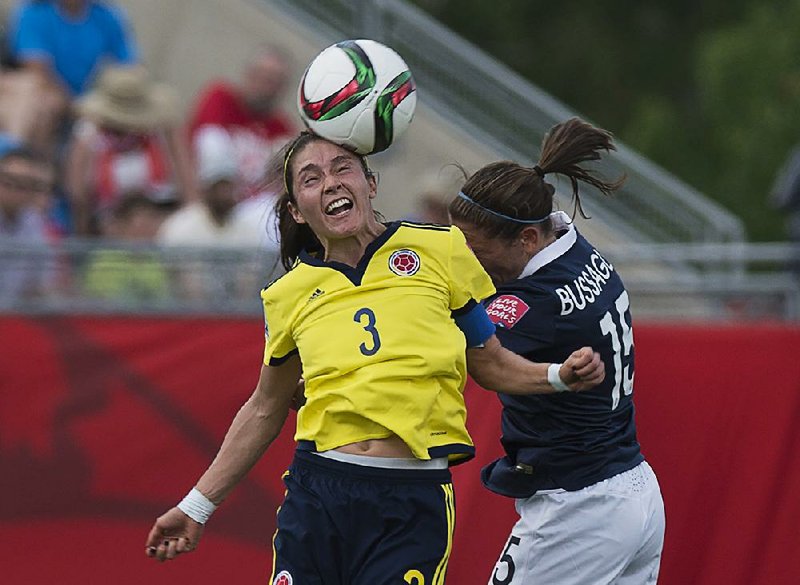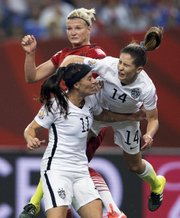Would soccer be safer if young players were not allowed to head the ball?
According to a new study of heading and concussions in youth soccer, the answer to that question is not a simple yes.
Soccer parents naturally worry about head injuries during soccer, whether a child's head is hitting the ball or another player. The resounding head-to-head collision between Alexandra Popp of Germany and Morgan Brian of the United States during the recent Women's World Cup sent shivers down spines.
Concerns about soccer heading and concussions have grown so insistent in the past year or so that some doctors, parents and former professional players have called for banning the practice outright among boys and girls up to about age 14, and curtailing it at other levels of play.
Ridding youth soccer of heading, these advocates say, would virtually rid the sport of severe head injuries.
But Dawn Comstock, for one, was skeptical when she heard about the campaign. An associate professor of public health at the University of Colorado in Denver and an expert on youth sports injuries, she is also, she said, "a believer in evidence-based decision making."
And she said she wasn't aware of any studies showing that heading causes the majority of concussions in the youth game. In fact, she and her colleagues could not find any large-scale studies examining the causes of concussions in youth soccer at all.
So, for a study published in July by JAMA Pediatrics, she and her colleagues decided to investigate the issue themselves.
They began by turning to the National High School Sports-Related Injury Surveillance Study, a large online database administered by Comstock that collates reports from hundreds of certified athletic trainers nationwide. The trainers enter information about how and when an injury occurs, during a practice or a game, for instance; what symptoms the athlete experiences; and how long it takes the player to return to play.
The database covers all types of injuries in almost every boys' and girls' high-school varsity sport. But in this instance, Comstock and her colleagues were interested only in concussions experienced in boys' and girls' soccer.
So they pulled the relevant data reported between 2005 and 2014, covering almost 3 million high-school soccer practices and games. The researchers were particularly interested in how players with concussions had been injured and whether they had been heading the ball at the time.
The first finding that leaped from the data was that concussions related to soccer are clearly rising.
The rate of head injuries among male and female high school players increased "substantially" throughout the years in question, the researchers found.
But heading the ball, it turned out, was not the leading cause of the injuries.
Instead, the overwhelming majority of concussions resulted from player-to-player contact, especially among boys. Almost 70 percent of soccer-related concussions in boys occurred when players collided, the researchers found. Among girls, the portion was 51 percent.
Heading played a role in many concussions. About a third of all concussions among male players involved heading, the data showed, as did about a quarter of those among female players.
But most of those injuries also involved player collisions, and it was the contact that typically caused the concussion, the researchers found, not the heading.
Fewer than 17 percent of concussions in boys and 29 percent in girls resulted from direct impact with a soccer ball.
BLOW THE WHISTLE MORE?
"What those numbers say to me is that banning heading" in youth soccer "would reduce the number of concussions," Comstock said, "but not nearly as much as people think that it would."
It would be "far more effective" she said, to teach young players better technique and sportsmanship, and to call fouls when they slam into one another. There is some evidence, she said, that referees call fewer fouls in amateur soccer games today than they did in years past, even as player contact has soared.
"If referees, coaches and players would enforce the existing rules," she said, there should be less physical contact and far fewer concussions among young players.
Of course, this study involved high school players, while the calls to ban heading generally focus on junior high and younger athletes. But no data exist about injuries in those age groups, Comstock said, so researchers have to rely on data from high school teams.
The results also do not show that heading is safe for players of any age, Comstock said, only that heading causes fewer concussions than slamming into another player does.
"We desperately need more research" into concussions, heading and young brains, she said.
But for now, reminding young athletes and their coaches to play cleanly and by the rules "could go a long way," she said, "toward making soccer more safe."
ActiveStyle on 08/03/2015


